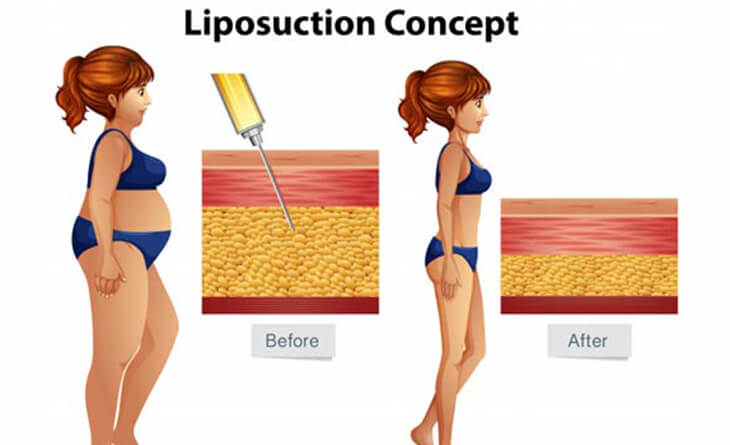Liposuction is a surgical procedure aimed at removal of unwanted fat from different areas of the body using a suction cannula attached to a vacuum suction machine.

Am I a candidate for liposuction?
Liposuction is a body contouring procedure meant to get rid of stubborn fat deposits. It is not primarily a modality for weight loss. If in spite of a healthy balanced nutritious diet and a regular exercise program, you are not still able to lose excess fat on specific areas of your body, you may be a candidate for liposuction.
Your suitability for liposuction also depends on your Body Mass Index (BMI). Body mass index or BMI is calculated by a simple formula: Your Body weight in kgs divided by square of your Height in mtrs. An ideal BMI is between 20-25
If your BMI is within 3-4 digits of your ideal BMI, you may be a good candidate for lipo-contouring or body shaping. This is essentially a procedure where specific areas of your body such as the abdomen, hips, waist-line, thighs are contoured towards a better aesthetic shape by strategically removing small quantities of fat. This gives you inch loss in the different areas that are shaped.
If your BMI is more than 3-4 near your ideal BMI but still less than 35, then after a very careful assessment and discussion with your qualified Aesthetic surgeon, you may still be a candidate for lipo-reduction. In lipo-reduction, larger volumes of fat can be removed from 2-3 specific areas of your body to reduce your weight as well as improve your contours. It also helps to reduce stress on major weight bearing joints (knees, hips, ankle) and on the back. Lipo-reduction has a safety limit of 8-10% of the total body weight at a time. Further reduction can only be done (IF necessary and desirable) after a minimum of 3 months and after regular exercise and dieting.
If your BMI is > 35 then you are a better candidate for bariatric or metabolic surgery. PLEASE NOTE THAT LIPOSUCTION IS NOT A SUBSTITUTE FOR PROPER DIET AND REGULAR EXERCISE, but just a step to enhance their effect to improve shape of the body further.
General information about the procedure
This is a surgical procedure like any other surgery except that the incisions are tiny and hidden in natural skin folds. A routine panel of blood tests, x-rays, sonography, ECG and any other tests are required as for any surgery.
Hospital admission is necessary and the procedure may be completed in Day care or require overnight stay in hospital. The anaesthesia chosen depends upon the plan of operation. It can be general/ spinal/ spinal with epidural or local anaesthesia with sedation.
Tiny cuts are made in natural folds or areas hidden by normal undergarments and a saline solution containing medication that reduces bleeding by constricting blood vessels is first infiltrated into the area which is to be liposuctioned. Once the solution has given the planned effect, the Aesthetic surgeon inserts the suction cannula which is attached to a suction machine through tubing and removes the excess fat.
At the end of the operation, the tiny incisions are stitched and dressed. Some surgeons may even opt to not suture these small openings. A special, customised, stretchable elastic compression garment is put on the patient, to control swelling, reduce fluid collection and allow the skin to drape well to the changed body shape. This needs to be worn 24/7 for 4-6 weeks
You should expect a certain amount of pain during the first few days depending upon the amount of liposuction done, the areas covered by the procedure and your pain tolerance. Analgesics to reduce pain are always prescribed. There are no restrictions on the patient’s activities or positioning as long as the patient is comfortable with the same. Plenty of oral fluid intake is recommended along with a healthy, nutritious, high protein diet to facilitate healing. Normal work with the garment in place can be resumed in 3-5 days. Any details about work restrictions and commuting can be discussed with the surgeon. Exercise and gym routine can be resumed as per individual pain tolerance.
You will notice swelling and bruising in the operated areas and often in the distal parts of the extremities, like feet and hands, if thighs and arms respectively have been liposuctioned. This will usually resolve within 10-14 days.

What kind of results can I expect?
Following the procedures, the final results will take about 3 months to be fully visible as healing takes place, swelling reduces and the tissues become soft and supple again. Gym work-outs and muscle-toning exercises always help to enhance the results further.
The degree of improvement varies from patient to patient. Sometimes minor surface irregularities may need secondary correction. If your skin is poorly elastic or there are pre-existing stretch marks or cellulite, the skin may remain slightly loose.
Do not check your weight immediately after the liposuction. For initial few weeks to a couple of months you may even find a gain on the weighing scale on account of the swelling that follows liposuction. After 3 months or so, as the swelling regresses, the weight will show the reduction based on the amount of liposuction done.
The primary aim of liposuction is “inch” loss and improved contouring. Weight loss due to fat removal is a bonus effect. Usually patients typically lose weight equivalent to 60-70% of aspirated fat volume. If you start toning your body and develop muscle mass, the results will show further improvement.
What can go wrong and how it can be remedied
Common immediate problems that arise can be bruising, swelling, burning pain in certain areas. They invariably settle with time. The operated area becomes firm to hard for few days to weeks after liposuction. This can be managed with manual lymphatic drainage or ultrasound massage.
Rarely there may be accumulation of fluid or blood under the skin (called seroma and hematoma respectively).
Persistent skin laxity may occur due to poor skin tone / elasticity.
Rarely, skin necrosis can occur either because of too aggressive liposuction or on account of infection. This may need surgery to clear the dead skin and cover.
Scar hypertrophy and keloid formation can occur in the small incisions.
Irregularities in contour may rarely persist and may require some correction.
Liposuction is a safe procedure provided some safety limits are not crossed. You must consult a qualified Aesthetic Surgeon alone for the procedure.
